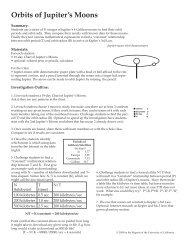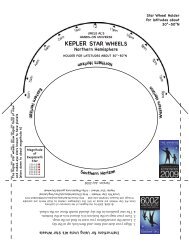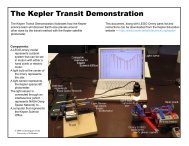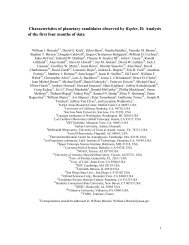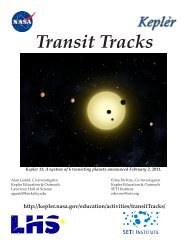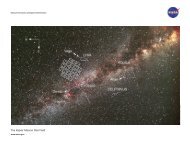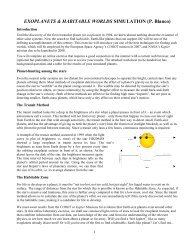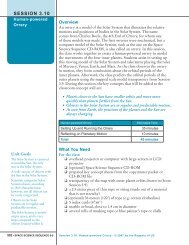Poster Abstracts - Kepler - NASA
Poster Abstracts - Kepler - NASA
Poster Abstracts - Kepler - NASA
- No tags were found...
You also want an ePaper? Increase the reach of your titles
YUMPU automatically turns print PDFs into web optimized ePapers that Google loves.
POSTER ABSTRACTSP0206. POSTER SESSION ICARMENES: A RADIAL-VELOCITY SURVEY FOR TERRESTRIAL PLANETS IN THE HABITABLEZONES OF M DWARFS. A. Quirrenbach 1 and the CARMENES Consortium, 1 Landessternwarte, Zentrum fürAstronomie der Universität Heidelberg (ZAH), Königstuhl 12, D-69117 Heidelberg, GermanyIntroduction: CARMENES (Calar Alto high-Resolution search for M dwarfs with Exo-earths withNear-infrared and optical Echelle Spectrographs) is anext-generation instrument to be built for the 3.5mtelescope at the Calar Alto Observatory by a consortiumof eleven Spanish and German institutions. Conductinga five-year exoplanet survey targeting ~300 Mdwarfs with the completed instrument is an integralpart of the project. The CARMENES instrument consistsof two separate échelle spectrographs covering thewavelength range from 0.55 to 1.7 μm at a spectralresolution of R = 85,000, fed by fibers from the Cassegrainfocus of the telescope. The spectrographs arehoused in vacuum tanks providing the temperaturestabilizedenvironments necessary to enable a 1m/sradial velocity precision employing a simultaneouscalibration with an emission-line lamp.Science Case: The fundamental scientific objectiveof CARMENES is to carry out a survey of latetypemain sequence stars with the goals of characterizingthe population of planets around these stars, and ofdetecting low-mass planets in their habitable zones(HZs). In the focus of the project are very cool starslater than spectral type M4V and moderately activestars, but the target list will also comprise earlier andtherefore brighter M dwarfs. In particular, we aim atbeing able to detect a 2M⊕ planet in the HZs of M5stars. A long-term radial velocity precision of 1m/s permeasurement will permit to attain this goal. For starslater than M4 (M < 0.25M⊙), such precision will yielddetections of super-Earths of 5M⊕ and smaller insidethe entire width of the HZ. For a star near the hydrogen-burninglimit, a planet with the mass of our ownEarth in the HZ could be detected at a precision of1m/s. In addition, the HZ of all M-type dwarfs can beprobed for super-Earths. Thus, a RV precision of 1m/scan trigger a breakthrough in exoplanet research in thespectral range of mid and late M-type stars.We plan to survey a sample of 300 M-type stars forlow-mass planet companions. Besides the detection ofthe individual planets themselves, the ensemble of objectswill provide sufficient statistics to assess theoverall distribution of planets around M dwarfs: frequency,masses, and orbital parameters. The surveywill confirm or falsify the seemingly low occurrence ofJovian planets around M stars, and the frequency of icegiants and terrestrial planets will be established alongwith their typical separations, eccentricities, multiplicities,and dynamics. Thus, the CARMENES survey canprovide the first robust statements about planet formationin the low-mass star regime.Instrument: For late-M spectral types, the wavelengthrange around 1000 nm (Y band) is the most importantwavelength region for RV work. Therefore, theefficiency of CARMENES will be optimized in thisrange. Since CCDs do not provide high enough efficiencyaround 1000 nm and no signal at all beyond theSi cutoff at 1100 nm, a near-IR detector is required.It is thus natural to adopt an instrument conceptwith two spectrographs, one equipped with a CCD forthe range 550-1050 nm, and one with HgCdTe detectorsfor the range from 0.9-1.7 μm. Each spectrographwill be coupled to the 3.5m telescope with its own opticalfiber. The front end will contain a dichroic beamsplitter and an atmospheric dispersion corrector, tofeed the light into the fibers leading to the spectrographs.Guiding is performed with a separate camera.Additional fibers are available for simultaneous injectionof light from emission line lamps for RV calibration.The spectrographs are mounted on benches insidevacuum tanks located in the coudé laboratory of the3.5m dome. Each vacuum tank is equipped with a temperaturestabilization system capable of keeping thetemperature constant to within ±0.01°C over 24h. Thevisible-light spectrograph will be operated near roomtemperature, the NIR spectrograph will be cooled to−80°C.The CARMENES instrument passed its preliminarydesign review in July 2011; completion of the instrumentis planned for late 2013. At least 600 useablenights have been allocated at the Calar Alto 3.5m Telescopefor the CARMENES survey in the time framefrom 2014 to 2018. The instrument is also well-suitedfor RV follow-up of planet candidates from transit surveys.More details can be found on the project webpage and in Quirrenbach et al. (2010).References:https://carmenes.caha.es/ext/index.html(CARMENES project public web page)Quirrenbach, A., Amado, P.J., Mandel, H., et al.(2010). CARMENES: Calar Alto high-Resolutionsearch for M dwarfs with Exo-earths with Nearinfraredand optical Echelle Spectrographs. InGround-based and airborne instrumentation for astronomyIII. Eds. McLean, I.S., Ramsay, S.K., &Takami, H., SPIE Vol. 7735, 773513, p. 1-141542011 <strong>Kepler</strong> Science Conference - <strong>NASA</strong> Ames Research Center



